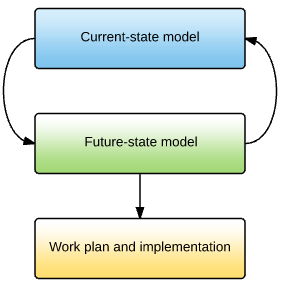Current vs. Future State Models
One of the first decisions you need to make before beginning your simulation project is to decide whether you should create a current-state or a future-state model. A current-state model depicts your current business system. The goal of a current-state model is to help you visualize and understand what is actually happening in your business system today. You can also use it to compare your simulation model to real-world performance to ensure that your model is accurate. By contrast, a future-state model will help you plan and design a more efficient business system that you will implement in the near future.
You probably decided to explore simulation modeling because you were dissatisfied with your current business system. For that reason, you might be tempted to jump right in and start creating a future-state model. However, many simulation theorists strongly advise against that and instead recommend starting with a current-state model first.
The process of creating a current-state model overlaps with the process of creating a future-state model and vice versa, as shown in the following image:

There are many advantages to starting with a current-state model:
- Good practice - If you're new to FlexSim and simulation modeling, creating a model of your current system first will help you to learn how to use these tools better. Consider practicing modeling with a current-state model until you can use the tools a little more instinctively.
- Information gathering - Creating a current-state model will force you to gather important information you'll need about how your business system really works. You'll have to go out onto the floor and talk to your employees about each step in your business system. In doing so, you'll begin to see your business system with fresh eyes.
- Validating your model - Once you've created a current-state model, you'll be able to compare your simulation model with how your business system operates in reality, which is called validating your model in the simulation industry. You can then determine if the model you've created accurately depicts reality. Once you've validated your model, you can then go on and make a future-state model knowing that the model you started with is accurate.
- Problem solving - Creating a current-state model actually helps you to see problems with the current system that may have otherwise been invisible to you. Many times as you are creating a current-state model, you will begin to realize exactly what needs to change about your business system. That's why some simulation practitioners recommend keeping track of an action list (a "to do" list) of things to change while working on a current-state model.
So, consider beginning your journey into simulation modeling by creating a current-state model first.